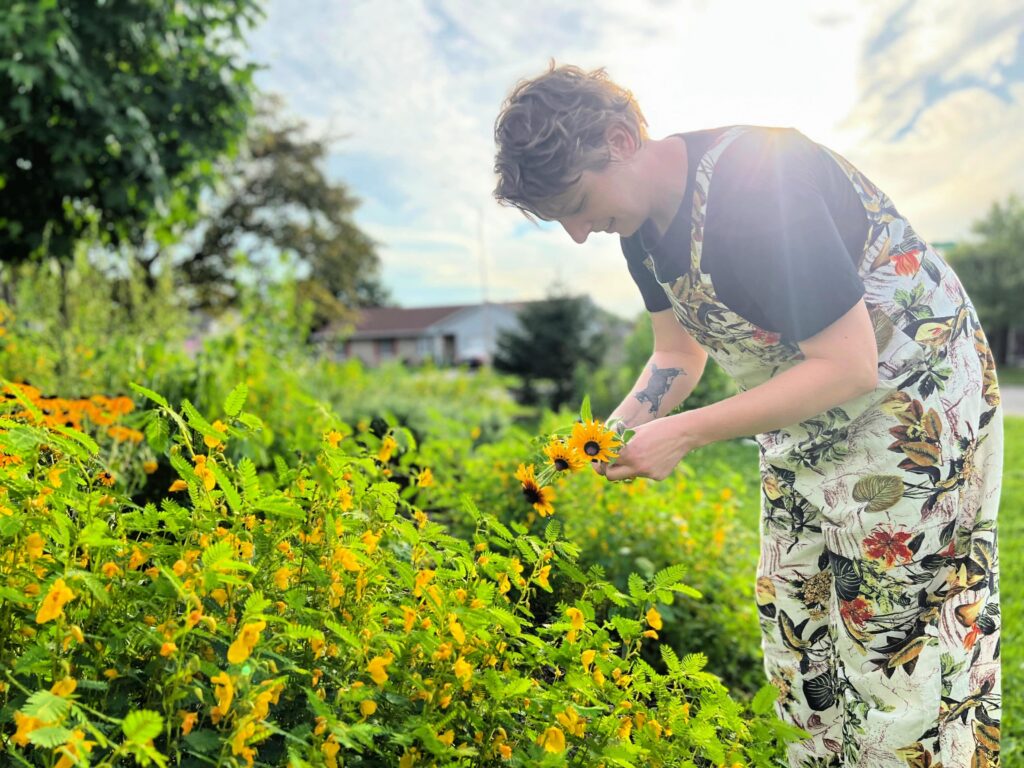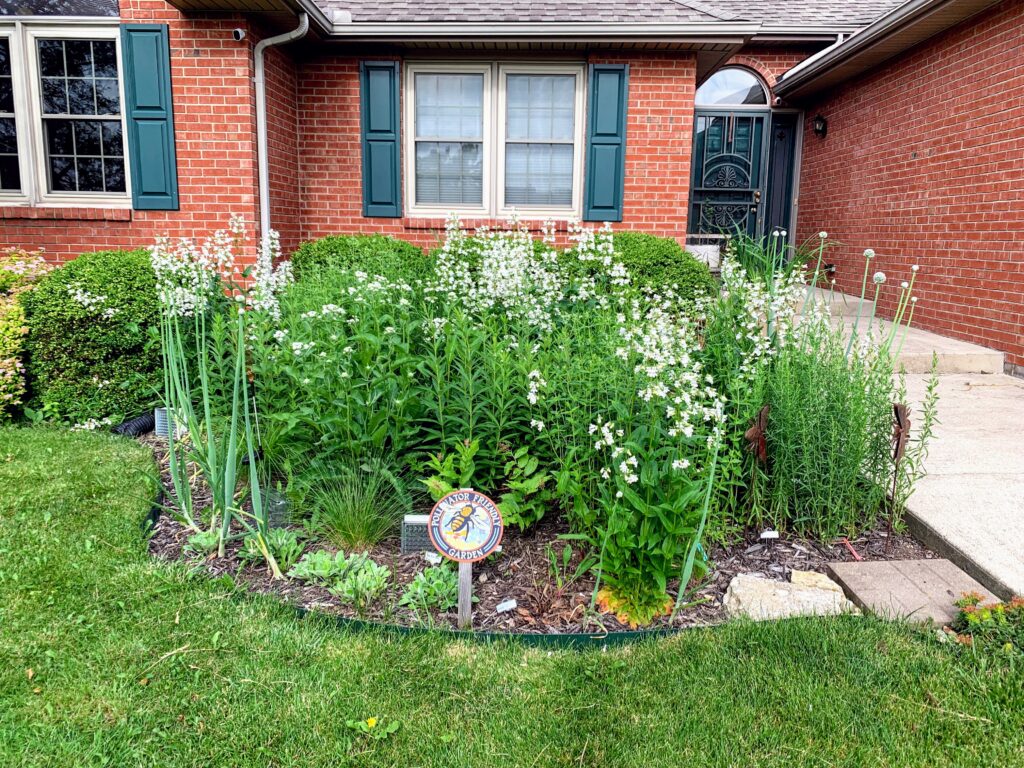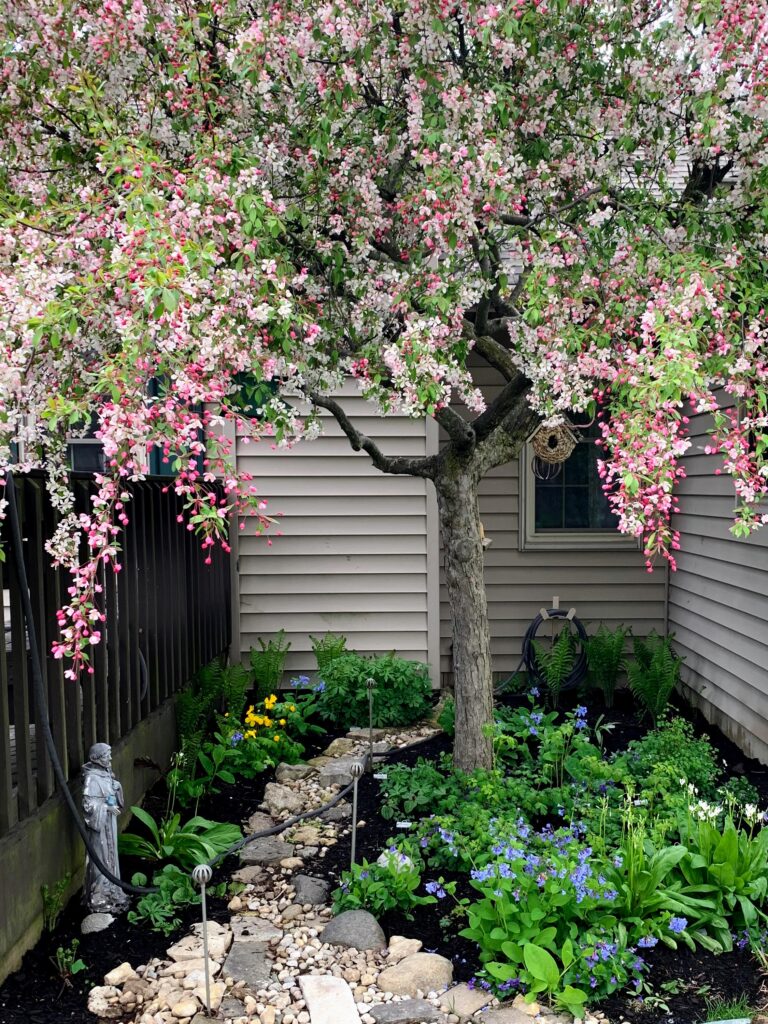From a chemically manicured landscape to a lush, living garden, Courtney Denning and her husband, Kenneth Brunson, have transformed their home and yard into an oasis where they can relax and enjoy nature.
This is an excerpt from the Wild Ones Journal
Current members can log in to read the latest issue or check out the Journal Archives.
And more importantly, they’ve transformed it into an area where birds, bees, butterflies, mammals and other animals can live and thrive.
Denning and Brunson purchased their home in 2016, and they immediately started replacing parts of their lawn with native plants. “At first, I focused on pollinator plants, not necessarily native plants,” she said. “But as I read more about gardening for wildlife and the importance of native plants, I began to focus more heavily on adding native plants.”

She said their home had very traditional landscaping when they moved in, so her initial focus was to remove invasive species like the
Bradford pear tree and burning bush shrubs. But instead of getting rid of all nonnatives, she decided to keep and relocate some plants like hostas.
“There were a lot of plants planted in the wrong areas, like hostas in full sun and peonies in full shade,” she said.
There was a method to her madness of creating new native beds. “I view problems we’ve had in our landscape as an opportunity to add native plants,” she said. “For example, our home came with a grafted dwarf crabapple with a weeping habit. It was a monster and took a long time to prune and shape it the way it was intended to look. So, we removed it and I created a bed of native plants to go in its place.”
In August, their garden was one of 19 homes that took part in a native yard tour, hosted by the Midwest Native Plant Society. The garden tour aimed to educate people about native landscapes that attract wildlife and support biodiversity.
Denning and her parents went on the first yard tour in 2021. When she heard that the Midwest Native Plant Society was looking for additional hosts for the 2022 tour, she was excited to volunteer her small suburban garden. She spent the next few months preparing her yard for guests.
“I tried to get everything weeded, cleaned up and finish as many projects as I could,” she said. For those areas not yet converted to natives, she included signs describing what was to come.
Their landscape includes various garden areas: a pocket prairie, redbud garden, moon garden, corner bed, woodland garden, wet/rain garden, shade garden, southwest garden and an edible garden. Their yard also includes a patio with a firepit and a water feature.
Denning said their yard is still a work in progress, with each section added one by one. Her favorite area, at least so far, is probably the first fully native bed they added, the pocket prairie, a rectangular bed in their front yard located near their driveway. She said that area took a joint effort with her husband and parents helping do everything from laying down cardboard to kill grass and removing sod, to planting and mulching.
“I was really nervous about doing it, especially since our next-door neighbors have a beautiful, traditionally landscaped yard,” Denning said. “I also spent a lot of time trying to keep it looking intentional.”
But the neighbor she worried most about has been one of the most supportive of their native landscaping.
“One day I was working in our pocket prairie in the front yard when the neighbor came over and said

he had noticed monarchs nectaring on our meadow and rough blazing star (Liatris ligulistylis and L. aspera) during the day and roosting in their bald cypress (Taxodium distichum) trees at night,” she said.
In addition, some of their plants, like smooth blue aster (Symphyotrichum laeve) have escaped to the neighbor’s yard, and so far, they’re still there and growing bigger.
Denning said she previously worked at a library, which closed for 12 weeks during the COVID-19 pandemic. “That gave me a lot of time to garden,” she said. And she used that time productively installing a fence, their edible garden area, a patio and the Southwest inspired planting in front of their patio. “I’ve really ramped up the number of new beds since 2020.”
Denning said their soil is primarily clay, rocks and pebbles left over from the construction of the neighborhood in the mid-1990s.
“It’s not easy to dig in, but the native plants I have planted have done well, and we use raised beds for edible gardening,” she said. “Our lot is pretty sunny; I have a single shady spot at the back of our house filled with shade-loving native plants. We have planted several trees and shrubs on the north side of our home and should have some more shady spots” in the future.
One of her goals is to rid the home of its Kentucky bluegrass lawn.
“My main focus with our garden is to create a habitat and an outdoor space that is enticing to wildlife and people,” Denning said. “I view my garden as an extension of our home and a place to relax and enjoy nature. I want to be an example of how to have an extensive garden without a lot of land.”
Denning admits she doesn’t spend much time relaxing at this point. “We don’t have any shade in our patio area where I could work on my laptop or read,” she said. “But I’m not good at relaxing. I’m either in the garden working or thinking about plants in the garden.”
Denning said working in her native flower beds also improves her mental health as it allows her to clear her head.
Already she is showing people that you don’t need a lot of land to make a difference. By planting more native plants, you will invite more pollinators into your yard.

“In my head, I used to think I needed acres of land to make an impact,” she said. “But by focusing on each part of each garden, I’ve learned what is possible even with a smaller space.”
In the future, Denning plans to add a greenhouse to the side of the garage, as well as find a spot to hang a hammock.
“I want a space that is dedicated to plants and is not dual purpose,” Denning said. “In the past I worked at a botanical garden, and I was able to go into the biodomes in the middle of winter and be in a tropical climate when snow is on the ground. I’d like to have a tiny slice of that again.”
For those new to native landscaping, Denning recommends they start small. She stresses they don’t need to immediately get rid of everything that is nonnative.
“At first, my thinking was very black-and-white and I was obsessive in an unhealthy way” when it came toward nonnative plants, she said. “But there’s no reason to rip out your favorite roses as long as they’re not invasive. But going forward, look to buy native plants from local nurseries.”
Be sure to purchase straight species, and not cultivars, she said. “If it’s got a clever or cute name on the tag, it’s a cultivar and it may not be as beneficial to pollinators. It’s just clever marketing and it’s not necessarily helpful to wildlife.”
Written by Barbara A. Schmitz.

